Different Types of Poplar Trees & Their Features
With thirty five true varieties, poplar trees have many cultivars as well. The most common poplar tree varieties are Black or White poplar, Eastern Cottonwood, Balsam Poplar, etc.
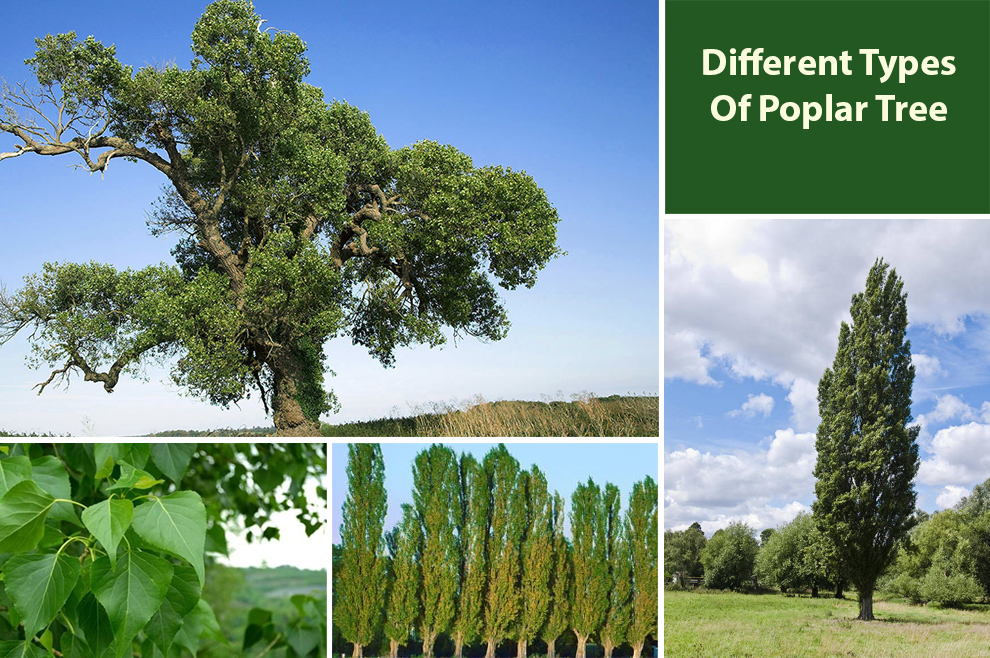
Poplar trees from the genus Populus are known for their versatility and grace. These deciduous trees are famous for their rapid growth, and you can find them across the world, especially in the Northern Hemisphere.
With approximately thirty-five recognized species, poplars have a magnificent diversity of features and forms.
While it may be challenging to encapsulate the different types of poplar trees in this guide, a few notable species include the black poplar (Populus nigra), trembling aspen (Populus tremuloides), eastern cottonwood (Populus deltoides), balsam poplar (Populus balsamifera), and white poplar (Populus alba).
Each type holds distinct characteristics, such as habitat preferences, bark color, and leaf shade, contributing to the captivating charm and ecological significance.
Poplar Tree Identification
| Poplar Tree Leaves | Large, deciduous leaves, typically triangular or ovate with serrated or toothed edges |
| Poplar Wood | Relatively soft and lightweight and usually pale to creamy white |
| Poplar Tree Fruit | Small capsules or catkins contain numerous tiny seeds and have cotton-like fluff. |
| Poplar Tree Uses |
|
| Poplar Buds | Slender and elongated buds covered in protective resin
Develop into flowers or leaves |
Different Kinds of Poplar Trees
- White Poplar
- Balsam Poplar
- Black Poplar
- Necklace Poplar
- Canadian Poplar
- Hybrid Poplar
- Lombardy Poplar
- European Aspen
- Cottonwood
Below we will take you through some well-renowned poplar tree species, highlighting their unique characteristics. It will help you decide which specie best suits your environment and liking.
A. White Poplar
| Soil & Sun | Variety of soil types, including loamy, sandy, and clay, but prefer moist to wet soil conditions and can tolerate periodic flooding.
Prefer full sun exposure, although they can tolerate partial shade |
| Mature Size | Medium-sized trees typically reaching a height of 50 to 80 feet (15 to 24 meters) at maturity with a 30 to 40 feet (9 to 12 meters) spread |
White poplar varieties are characterized by their distinctive silver-white bark, which stands out in the green landscape. They have heart-shaped leaves and a glossy green upper surface, whereas the underside has a white, woolly texture.
It builds a fascinating contrast when the wind blows and exposes the silvery undersides. Some notable cultivars of the white poplar are Pyramidalis, which has a columnar, narrow shape, and Silver Queen, known for its particularly pronounced silver-white foliage.
These features add to the white poplar tree’s aesthetic appeal in different landscapes.
B. Balsam Poplar
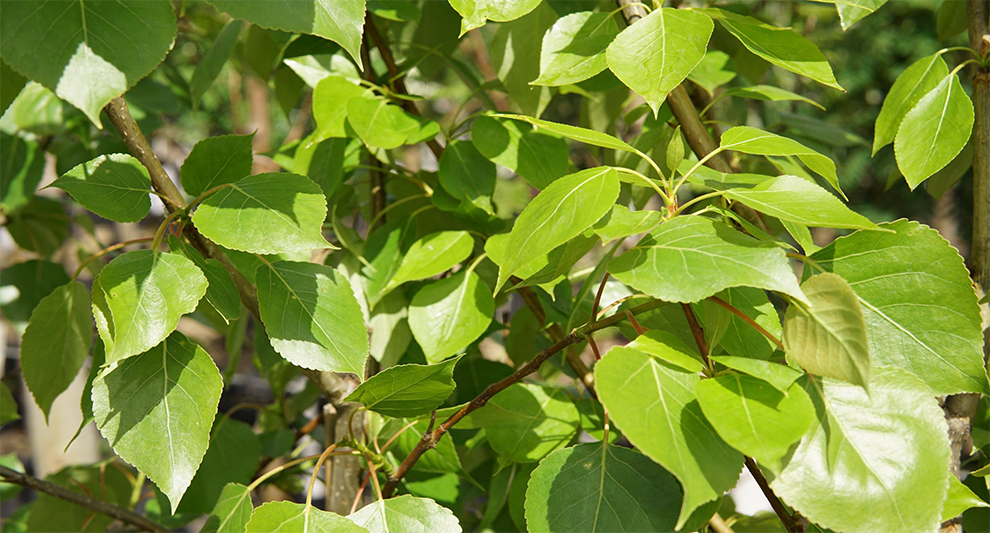
| Soil & Sun | Adaptable to various soil types, including loamy, sandy, and clay soils, but prefer moist to wet soil conditions. They can also endure occasional flooding. They thrive in full sun exposure but can tolerate partial shade as well. |
| Mature Size | 60 to 90 feet (18 to 27 meters) with a 40 to 60 feet spread creating an open and broad crown |
Balsam poplars are characterized by their grayish-green, smooth bark that becomes furrowed and darkens with age. Its leaves are broadly triangular or oval with serrated edges.
They have a dark green, glossy upper surface and a yellowish or lighter green underside. The buds in these poplar species are resinous and emit a pleasant balsam fragrance when crushed.
The distinctive features and size make Balsam poplar trees visually appealing and add an aromatic touch to the landscape.
C. Black Poplar
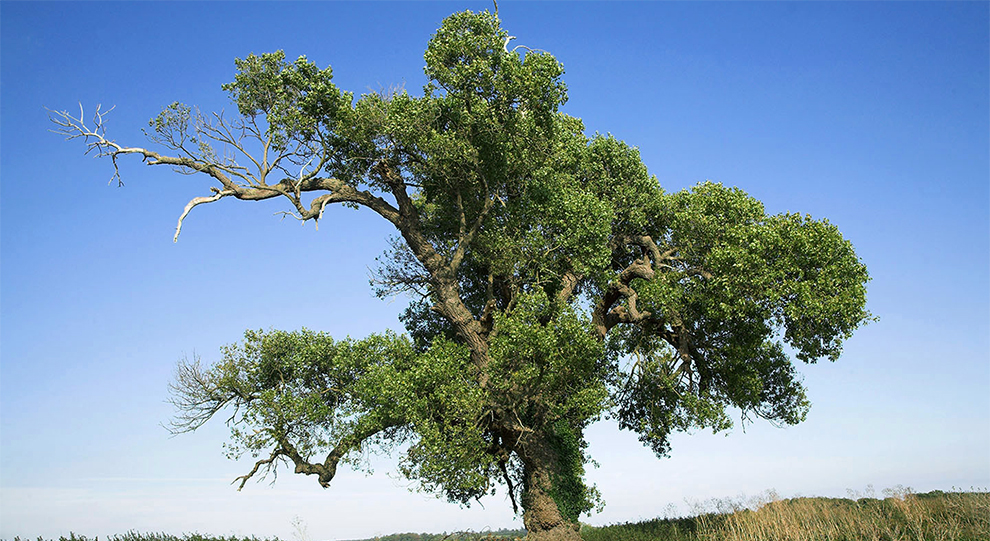
| Soil & Sun | Wide range of soil types, including clay, loam, and sandy soils, but prefer moist to wet soil conditions and can endure full sun or partial shade. |
| Mature Size | 65 to 100 feet (20 to 30 meters with a 40 to 60 feet (12 to 18 meters), forming a broad and rounded crown |
Black Poplars have rough, dark, rough bark, which becomes deeply furrowed as the tree grows. The leaves are triangular or diamond-shaped with serrated edges and a glossy dark green color.
You can find different types of poplar trees in this variety. Some notable varieties of black poplar include Lombardy poplar, which has an upright or fastigiate growth habit, and Nigra, which has a deeper green foliage and compact form.
These features add to the black poplar’s distinctive appearance.
D. Necklace Poplar
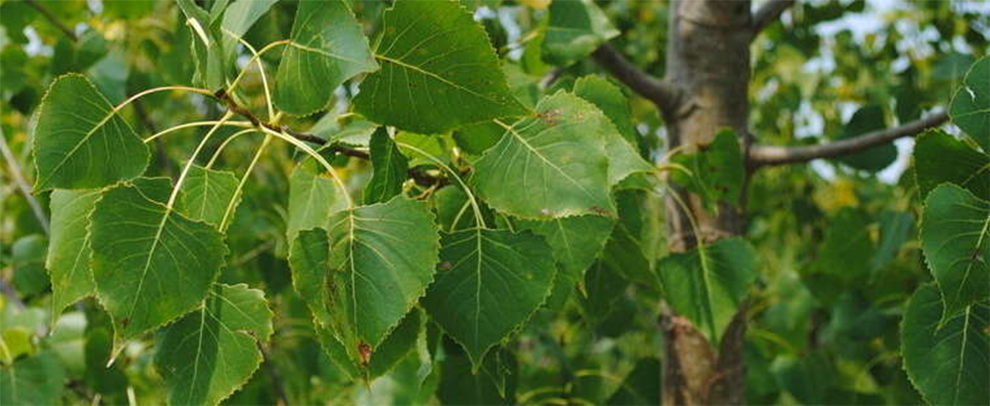
| Soil & Sun | Various soil types, including loam, clay, and sandy soils, but prefer moist to wet soil conditions and need full sun exposure for optimal growth. |
| Mature Size | 60 to 80 feet (18 to 24 meters) with a 40 to 50 feet (12 to 15 meters) spread, creating a rounded and broad crown |
Necklace poplars depict a grayish-brown bark with distinctive diamond-shaped lenticels. The leaves are heart or triangular-shaped with serrated edges and glossy green color.
Among the different kinds of poplar trees, the Serotina variety of necklace poplar is known for its greenish-yellow flowers that appear in pendant-like small clusters that show in late spring. These features give the tree a unique name and add to its visual appeal.
E. Canadian Poplar
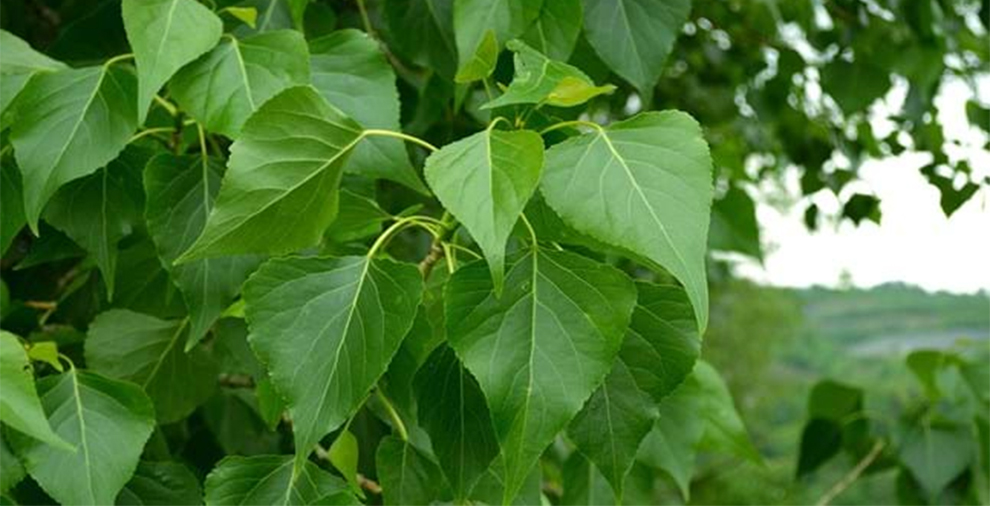
| Soil & Sun | Various soil types, including loam, clay, and sandy soils but prefer moist to wet soil and can tolerate full sun or partial shade. |
| Mature Size | 60 to 80 feet (18 to 24 meters) with a 40 to 50 feet (12 to 15 meters), creating a broad and rounded crown |
They have a grayish-brown and smooth bark, which becomes furrowed as the tree ages. Its leaves are heart-shaped or triangular with a vibrant green hue and serrated edges.
As a hybrid species, you can find different types of poplar trees within Canadian poplars exhibiting unique adaptations and characteristics.
F. Hybrid Poplar
| Soil & Sun | Adaptable to various soil types, including loamy, sandy, and clay soils but prefer moist to wet soil conditions and need full sun exposure for optimal growth. |
| Mature Size | Range from medium-sized to large-sized trees, with heights typically ranging from 40 to 100 feet (12 to 30 meters) and spreads varying accordingly |
Hybrid poplars inherit traits from their parent species, comprising leaf shapes, range of bark colors, and growth habits.
Some popular hybrid poplar varieties include Populus deltoides x Populus nigra crosses that exhibit a potpourri of characteristics from their parent species.
These hybrids are cultivated for their rapid growth. They are also better suited for energy or timber production.
G. Lombardy Poplar
| Soil & Sun | Thrive in a variety of soil types, including loamy, sandy, and clay soils but prefer moist to wet soil conditions and need full sun exposure for optimal growth. |
| Mature Size | 40 to 60 feet (12 to 18 meters) |
These types of poplar trees have a distinctive columnar shape with dense branches. Its leaves are diamond-shaped or triangular with a bright green color and serrated edges.
Its ‘Italica’ variety is known for its tall and slender form, making it a popular choice for landscape planting and windbreaks.
H. European Aspen
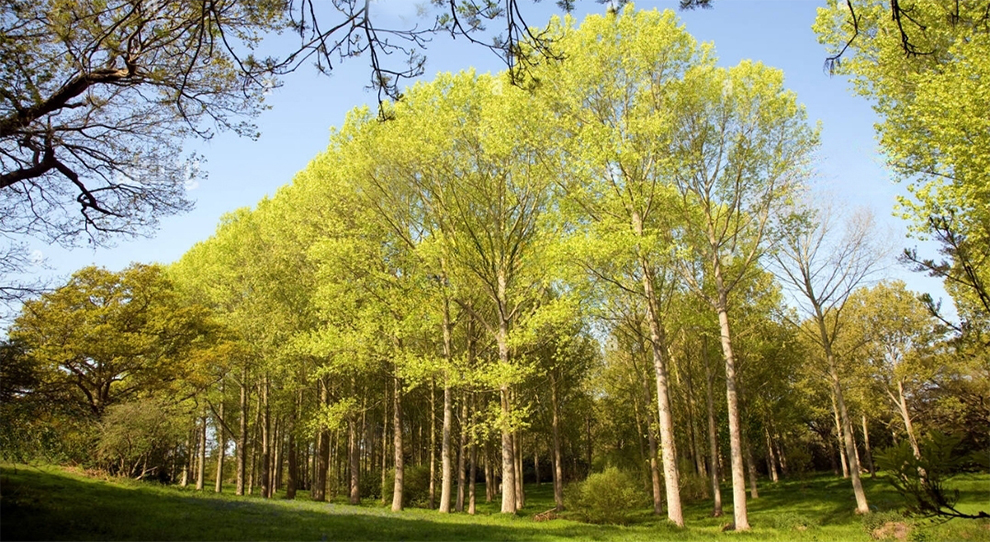
Also called the Populus tremula, the European Aspen is a poplar tree. It is a deciduous plant native to parts of Asia and Europe. Aspen thrives in well-drained, moist soil and can endure different light conditions, from full sun to partial shade.
It has a mature size of 50 to 80 feet (15 to 24 meters) with a 20 to 40 feet (6 to 12 meters) spread.
The plant is serrated and round with a vibrant green color, which turns golden-yellow in the fall. Its bark is grayish-green and smooth, developing black furrows as the tree matures.
I. Cottonwood (Black, Eastern, Fremont)
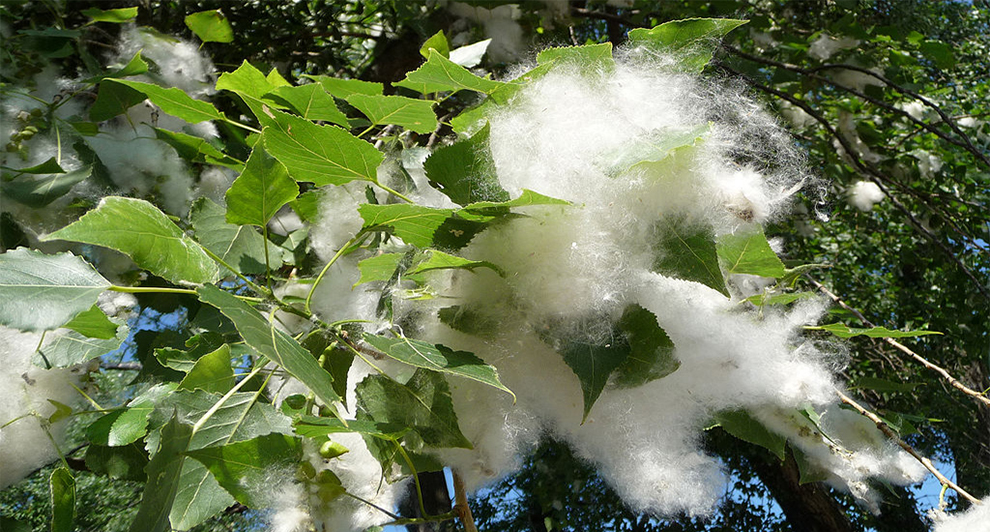
It comprises a group of trees from the Populus genus, the same genus as Poplars. They belong to the vaster family Salicaceae, commonly known as the willow family. You can find different cottonwood tree species under this, such as:
1. Black Cottonwood (Populus trichocarpa): A deciduous tree native to western North America that thrives in moist to wet soil conditions and full sun exposure.
It can reach an impressive height between 100 to 150 feet at maturity. They are heart-shaped, broad leaves with toothed edges characterized by their dark gray bark.
2. Eastern Cottonwood (Populus deltoides): It is a fast-growing tree native to central and North America. The plant thrives in moist soil and seeks full sun for optimal growth.
Eastern Cottonwood trees can grow at least 80 to 100 feet or more. Its leaves are triangular with a bright green color and serrated edges. They are known for their cotton-like seeds yielded in large quantities during the summer.
3. Foremonth Cottonwood is a native tree of northern Mexico and the Southwestern United States that prefers moist soil, especially near water sources like streams and rivers.
These trees grow up to 60 to 90 feet (18 to 27 meters) and have triangular leaves, coarsely toothed edges, and a dull green color. Like other cottonwoods, it produces cotton-like seeds that aid in wind dispersal.
Hence, European Aspen is a poplar specie, and Cottonwood trees, including Black Cottonwood, Eastern Cottonwood, and Fremont Cottonwood, are part of the same genus as poplars but belong to the family Salicaceae.
Debunking Some Myths
Myth – The tulip tree is one of the true poplar varieties.
Fact – The Tulip tree, scientifically called the Liriodendron tulipifera, is commonly called a tulip poplar but is not a true poplar tree. It belongs to the Magnoliaceae family, not the Populus genus of true poplars.
Myth – Poplar trees are closely related to willow trees.
Fact – While willow and poplar trees share some similarities, they are not closely related. Poplar trees belong to the Popular genus, family Salicaceae, whereas Willow trees are from the Salix genus in the family Salicaceae.
Though they are from the same family, they are separate genera with distinct characteristics and evolutionary lineages. Hence, poplar and willow trees are not closely related, despite their occasional similarities in appearance and habitat preferences.
Where Do Poplar Trees Grow?
Poplar trees are found in different regions across the world, especially in the Northern Hemisphere. They are distributed in North America, Asia, and Europe. Poplar trees thrive in temperate regions and can grow in different soil types, such as wet or moist conditions.
What Species Is Poplar Wood?
Poplar wood mainly comes from different poplar species from the Popular genus, such as Populus tremula, Populus balsamifera, and Populus nigra.
The wood is relatively soft and lightweight, making it ideal for different applications, such as furniture, cabinetry, veneers, and pulpwood for paper production.
What Are The Three Benefits Of Poplar?
The three main benefits of growing poplar trees are:
- Courtesy of their rapid growth rate, Poplar trees are a valuable resource for wood and timber products. Their fast growth allows sustainable harvesting and lowers the pressure on slower-growing species.
- Poplar trees absorb carbon dioxide from the atmosphere and sequester it in their biomass. It makes them vital allies in mitigating climate change by lowering greenhouse gas concentrations.
- Poplar trees have an extensive root system stabilizing the soil and preventing erosion. They are employed in the riparian zone, along riverbanks, and in areas susceptible to landslides to serve this purpose.
In this guide check out how fast poplar trees grow.
These benefits make them valuable in different fields, such as renewable resources, forestry, and environmental conversion.
